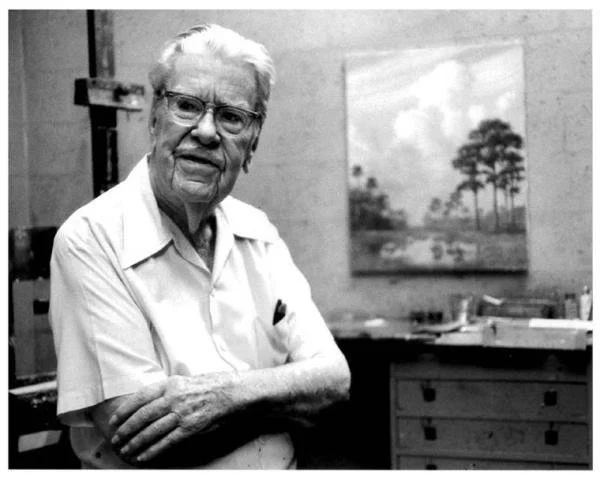Albert Ernest Backus (1906-1990)
Available Works
Biography
Albert Ernest “Beanie” Backus (American, 1906-1990) was a Florida-based artist best known for his landscape paintings and his mentorship of young artists. Regarded as the “dean” of Florida landscape art, Backus’s work helped to create the national image of midcentury Florida. His mentorship to dozens of Florida artists resulted in his work being a major influence on the development of the Indian River School and the Florida Highwaymen. Backus’s masterful use of light and color and his naturalist’s eye for flora and fauna make his paintings both romantic and accurate depictions of the Florida landscape.
Backus was born in Fort Pierce, Florida in 1906. He began painting at a young age and was largely self taught, but spent two summers studying at Parson School of Design in New York. Early in his career Backus worked as a commercial artist, but with the onset of the Great Depression began selling his own paintings at art shows. Throughout the 1930s he gained statewide and national recognition, and in 1931 he had his first solo exhibition, sponsored by a Fort Pierce patron named Dorothy Binney Palmer. In 1942 Backus enlisted in the US Navy, serving throughout WWII as a quartermaster on the USS Hermitage AP-54 and spending his shore leave painting international ports around the world.
Following his return from the war, Backus enjoyed widespread commercial success. He purchased his family’s old boat works in Fort Pierce. Known as the “Old Studio”, Backus lived and worked there from 1946-1960. During this time Backus would create some of his most colorful and energetic paintings, beginning to use a palette knife to achieve a thick impasto effect. He also began to teach art lessons to local young people and to mentor aspiring artists. Among these early pupils were Alfred Hair (1941-1970) and Harold Newton (1934-1994), two young Black men who would go on to found the Florida Highwaymen. Backus was briefly married to Patricia Hutchinson, from 1950 to 1955 when she died. Distraught at her death he visited Jamaica, and the tropical environment introduced warmer color palettes and more figures into the artist’s work. In 1960 Backus moved to his “New Studio” on 122 Avenue C in Fort Pierce, marking his metamorphosis from emerging to established artist. The style of his work became more refined and detail-oriented, characterized by a return to brushwork and the creation of more polished surfaces. His subject matter shifted as well, featuring more savannahs, glades, rivers, and backcountry scenes of rural Florida.
Backus’s later years saw him achieve the highest honors of his career, being increasingly recognized as one of Florida’s most significant artists and an important figure in racial justice and reconciliation. He began to be referred to as “Florida’s painter laureate,” and by 1968 was declared the “Dean of Florida’s landscape painters.” In the 1960s, he was one of the community leaders appointed to Fort Pierce’s first Bi-Racial Commission. In 1979 Governor Bob Graham declared him to be the “best-known representational artist in the state” at a ceremony in Tallahassee. And in 1980, Florida Atlantic University conferred an honorary degree of Doctor of Humane Letters. His paintings are included in private and public collections all over the United States, including in the Lyndon B. Johnson Memorial Library and the personal collection of former US Senator Bob Graham. After suffering a series of heart attacks, Backus died in 1990.

